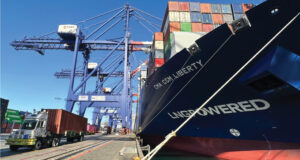*By Col. (Ret.) Robert Sinkler*

United States policy has traditionally treated a “port” as a single geographic location, usually identified with a town or city. Occasionally, a port could also refer to a natural harbor or side channel, or even a river section with a natural bank or shoreline conducive to loading and unloading.
Unfortunately, many communities and local governments along inland waterways are limited by this thinking. For example, Iowa is America’s second largest agricultural exporter with $10.6 billion in total exports according to 2018 U.S. Department of Agriculture figures (http://bit.ly/IowaTradeStats, http://bit.ly/2018USDOTfigures). But Iowa is also the only major exporting state on the inland waterway system that is not served by a federally recognized port.
With a federal port designation, port areas are in a much better position to attract public and private investment and be more competitive when it comes to state and federal grants. The designation supports regional marketing and economic development objectives. It increases regional, national and global visibility. It also enhances competitiveness and creates an important regional identity.
When I commanded the Army Corps of Engineers Rock Island (IL) District, I worked with several riverfront communities that had no appreciation for the quantity and value of goods shipped from nearby barge terminals just outside city limits. Residents were aware of the extensive barge traffic, but they did not know whether cargo originated from in-state or another state. In several cases, roads servicing these barge terminals were not appropriately planned and maintained. In short, the larger regional port identity just did not exist.
But this traditional way of viewing ports is rapidly changing. First, our roads and rail lines increasingly intersect with narrow inland rivers and waterways. Second, large industrial and agricultural terminals, particularly in the U.S. Midwest, are being built along narrow waterways outside of nearby communities. As a result, functioning ports have evolved into extended infrastructure operations, sometimes reaching more than 200 miles like the Ports of Cincinnati and Northern Kentucky.
Regional planning authorities are carefully designing road, rail and barge terminal infrastructure and facilities to maximize the value of this integrated transportation network over large areas. This means overcoming significant institutional challenges, including governance, the role of private industry, financing the transportation system, and infrastructure development to realize regional capacity improvement.
 AAPA Seaports
AAPA Seaports


